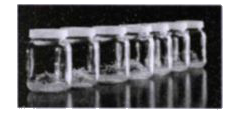The rate of growth of bacteria is proportional to the number present . If initially, there were 1000 bacteria and the number doubles in 1 hours. Find the number of bacteria after 212 hours . [ take √2=1.414]
To solve the problem of bacterial growth, we will follow these steps:
Step 1: Set up the differential equation
The rate of growth of bacteria is proportional to the number present. We can express this as:
dndt=kn
where n is the number of bacteria, t is time, and k is the proportionality constant.
Step 2: Separate variables and integrate
We can rearrange the equation to separate the variables:
dnn=kdt
Now, we integrate both sides:
∫dnn=∫kdt
This gives us:
lnn=kt+C
where C is the constant of integration.
Step 3: Solve for the constant of integration
We know that initially (at t=0), there were 1000 bacteria:
ln(1000)=k(0)+C⟹C=ln(1000)
So, our equation becomes:
lnn=kt+ln(1000)
Step 4: Rewrite the equation
We can rewrite the equation using properties of logarithms:
lnn−ln(1000)=kt⟹ln(n1000)=kt
Exponentiating both sides gives:
n1000=ekt⟹n=1000ekt
Step 5: Find the value of k
We are given that the number of bacteria doubles in 1 hour. Therefore, when t=1:
n=2000(since it doubles from 1000)
Substituting into the equation:
2000=1000ek(1)⟹2=ek⟹k=ln(2)
Step 6: Substitute k back into the equation
Now we substitute k back into our equation for n:
n=1000e(ln(2))t
This simplifies to:
n=1000⋅2t
Step 7: Find the number of bacteria after 2.5 hours
Now we need to find n when t=2.5:
n=1000⋅22.5
We can express 22.5 as:
22.5=22⋅20.5=4⋅√2
Substituting this back:
n=1000⋅4⋅√2=4000⋅√2
Step 8: Substitute the value of √2
Given √2=1.414:
n=4000⋅1.414=5656
Final Answer
Thus, the number of bacteria after 2.5 hours is approximately:
5656
The rate of growth of bacteria is proportional to the number present. We can express this as:
dndt=kn
where n is the number of bacteria, t is time, and k is the proportionality constant.
We can rearrange the equation to separate the variables:
dnn=kdt
Now, we integrate both sides:
∫dnn=∫kdt
This gives us:
lnn=kt+C
where C is the constant of integration.
We know that initially (at t=0), there were 1000 bacteria:
ln(1000)=k(0)+C⟹C=ln(1000)
So, our equation becomes:
lnn=kt+ln(1000)
We can rewrite the equation using properties of logarithms:
lnn−ln(1000)=kt⟹ln(n1000)=kt
Exponentiating both sides gives:
n1000=ekt⟹n=1000ekt
We are given that the number of bacteria doubles in 1 hour. Therefore, when t=1:
n=2000(since it doubles from 1000)
Substituting into the equation:
2000=1000ek(1)⟹2=ek⟹k=ln(2)
Now we substitute k back into our equation for n:
n=1000e(ln(2))t
This simplifies to:
n=1000⋅2t
Now we need to find n when t=2.5:
n=1000⋅22.5
We can express 22.5 as:
22.5=22⋅20.5=4⋅√2
Substituting this back:
n=1000⋅4⋅√2=4000⋅√2
Given √2=1.414:
n=4000⋅1.414=5656
Thus, the number of bacteria after 2.5 hours is approximately:
5656
Topper's Solved these Questions
- DIFFERENTIAL EQUATIONS Book:NAVNEET PUBLICATION - MAHARASHTRA BOARDChapter:DIFFERENTIAL EQUATIONS Exercise:Examples for practice
Explore 15 Videos
- DIFFERENTIAL EQUATIONS Book:NAVNEET PUBLICATION - MAHARASHTRA BOARDChapter:DIFFERENTIAL EQUATIONS Exercise:Examples for practice (2)
Explore 18 Videos
- DEFINITE INTEGRALSBook:NAVNEET PUBLICATION - MAHARASHTRA BOARDChapter:DEFINITE INTEGRALSExercise:MULTIPLE CHOICE QUESTIONS
Explore 10 Videos
- DIFFERENTIATIONBook:NAVNEET PUBLICATION - MAHARASHTRA BOARDChapter:DIFFERENTIATIONExercise:MCQ
Explore 15 Videos
Similar Questions
Knowledge Check
The rate of increase in the number of bacteria in a certain bacteria culture is proportional to the number present. If in 5 hrs the number triples, then in 10 hrs, the number of bacteria present is
A18 times the originalB12 times the originalC6 times the originalD9 times the originalRead the following text and answer the following questions on the basis of the same: The rate of increase in the number of bacteria in a certain bacteria culture is proportional to the number present. Given that the number triples in 5 hours.

If N0 is the initial count of bacteria, after 10 hours the count is __________ .A15log3B3logN0C9N0D2N0The rate of increase in the number of bacteria in a certain becteria culture is propotional to the number present at that time. If initiallly there are 300 bacteria and after 2 hours, the bacteria polulation is increased by 20% then after 24 houre, the number of bacteria are (log1.2=0.18232,e2.18784=8.9166)
A2675B2674C3210D3209
Bacteria increases at the rate proportional to the number of bacteria present. If the original number N doubles in 3 hours, find in how many hours the number of bacteria will by 4N ?
View SolutionThe rate of increase of the bacteria in a culture is proportional to the number of bacteria present and it is found that the number doubles in 6 hours. Prove that the bacteria becomes 8 times at the end of 18 hours.
View SolutionThe rate of increases of bacteria in a certain culture is proportional to the number present. If it doubles in 5 hr., then in 25 hr., its number would be
View SolutionRead the following text and answer the following questions on the basis of the same: The rate of increase in the number of bacteria in a certain bacteria culture is proportional to the number present. Given that the number triples in 5 hours.

If 'N' is the number of bacteria, the corresponding differential equation is ____________ .
View SolutionThe rate of increase in the number of bacterai in a certain becteria culture is propotional to the number present at that time. If is found that the number doubles in 4 hours, then at the end of 12 hours, the number of bacteria are
View Solution

